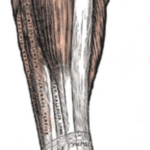Shin splints, which are caused by a weak shin bone and a tight calf muscle, are extremely painful and can continue to damage your body if they aren’t caught early. You can develop shin splints in both legs or in just one and the pain can be excruciating. The most common problem associated with shin splints is that they often occur with extremely active individuals who feel they must just “tough it out. This can easily exacerbate the problem and lead to more serious complications. When you feel intense pain during exercise or sports, you are much better off attempting to deal with the problem.
Stop Physical Activity
As soon as you begin to suspect that you have shin splints, stop your physical activity. You shouldn’t go back to jogging or playing sports or working out until the problem is resolved, which could take several weeks. You’ll need to allow your muscles to heal, and then you should work on stretching your calf muscle and strengthening your shin muscle to make sure the shin splints don’t recur. If you aren’t sure how you should handle the problem, speak with a licensed physical therapist.
Ice the Muscles
The best thing you can do as an immediate treatment for shin splints is to ice your muscles. Most drug stores sell ice bandages that can be fastened around the shin to provide constant, compressed pressure. If you don’t have access to an ice bandage, simply place an ice pack around your leg and strap it to the bond with an elastic Ace bandage. The ice should stay on your leg for at least twenty minutes and be repeated every four hours for at least a day.
Elevate Your Leg(s)
In the case of shin splints, inflammation will be reduced by elevating your leg above your heart. Try lying on the couch with two or three pillows under your leg, or do the same in bed. While sleeping, you should likewise keep your leg elevated to avoid rapid inflammation or heat. If you aren’t able to walk without severe pain, you should also use crutches until the swelling and pain has lessened.
Begin Exercising
After three or four days of rest, begin an exercise regimen that allows you to stretch your calf muscles and strengthen the skin muscles. You can find such exercises at SportsInjuryBulletin.com and TheStretchingHandbook.com. These exercises will help to avoid shin splints in the future while providing you with increased flexibility and strength in your legs.
Wear Proper Shoes
Before resuming your normal exercise or sports routine, make sure that your footwear is adequate. Shin splints can develop by putting incorrect pressure on your feet or wearing shoes that cause you to move in an incorrect manner. Talk with the sales clerk at your local shoe store about finding proper footwear.
Try Cross-Training
Often, people who suffer from shin splints are at risk because their daily exercise takes the same form each time. By varying the types of exercise in which you engage, you’ll strengthen your legs in different ways, thereby lessening the possibility of getting shin splints.





